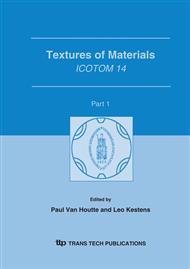p.3
p.13
p.23
p.31
p.45
p.57
p.63
p.69
p.77
Microstructure Sensitive Design with First Order Homogenization Theories and Finite Element Codes
Abstract:
A mathematical framework called Microstructure Sensitive Design (MSD) has been developed recently to solve inverse problems of materials design, where the goal is to identify the class of microstructures that are predicted to satisfy a set of designer specified objectives and constraints [1]. This paper demonstrates the application of the MSD framework to a specific case study involving mechanical design. Processing solutions to obtain one of the elements of the desired class of textures are also explored within the same framework.
Info:
Periodical:
Pages:
23-30
Citation:
Online since:
September 2005
Authors:
Price:
Сopyright:
© 2005 Trans Tech Publications Ltd. All Rights Reserved
Share:
Citation:


